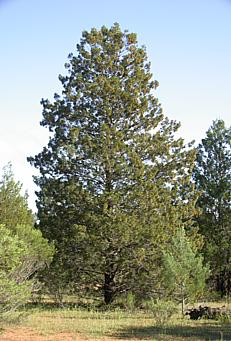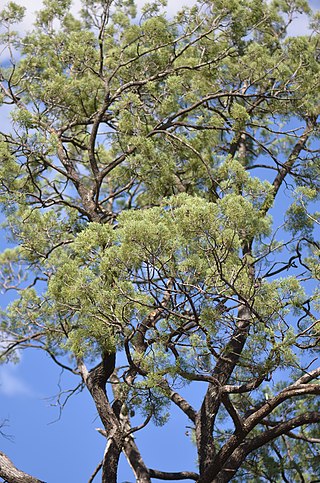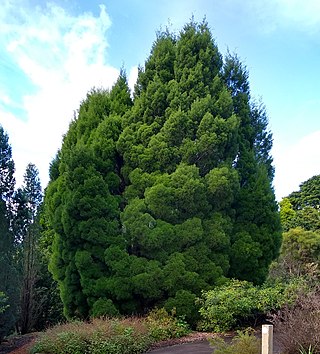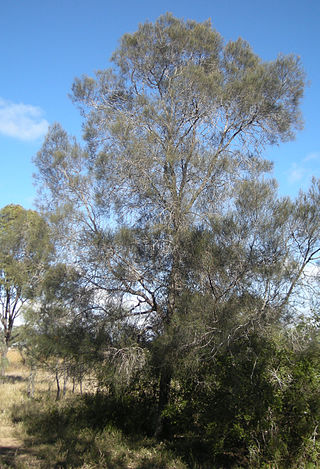Cypress is a common name for various coniferous trees or shrubs of northern temperate regions that belong to the family Cupressaceae. The word cypress is derived from Old French cipres, which was imported from Latin cypressus, the latinisation of the Greek κυπάρισσος (kyparissos). Cypress trees are a large classification of conifers, encompassing the trees and shrubs from the cypress family (Cupressaceae) and many others with the word cypress in their common name. Many cypress trees have needle-like, evergreen foliage and acorn-like seed cones.

Cupressus arizonica, the Arizona cypress, is a North American species of tree in the cypress family Cupressaceae, native to the southwestern United States and Mexico. Populations may be scattered rather than in large, dense stands.

Callitris is a genus of coniferous trees in the Cupressaceae. There are 16 recognized species in the genus, of which 13 are native to Australia and the other three native to New Caledonia. Traditionally, the most widely used common name is cypress-pine, a name shared by some species of the closely related genus Actinostrobus.

Actinostrobus pyramidalis, commonly known as swamp cypress, Swan River cypress and King George's cypress pine, is a species of coniferous tree in the Cupressaceae. Like the other species in the genus Actinostrobus, it is endemic to southwestern Western Australia.

Callitris columellaris is a species of coniferous tree in the family Cupressaceae, native to most of Australia. Common names include white cypress, white cypress-pine, Murray River cypress-pine, and northern cypress-pine. Callitris columellaris has become naturalised in Hawaii and in southern Florida.

Eucalyptus melliodora, commonly known as yellow box, honey box or yellow ironbark, is a species of medium-sized to occasionally tall tree that is endemic to south-eastern, continental Australia. It has rough, flaky or fibrous bark on part or all of the trunk, smooth greyish to yellowish bark above. The adult leaves are lance-shaped to egg-shaped, the flower buds are arranged in groups of seven and the fruit is more or less hemispherical.
Actinostrobus acuminatus, commonly known as dwarf cypress, creeping pine or Moore cypress pine, is a species of coniferous tree in the Cupressaceae. Like the other species in the genus Actinostrobus, it is endemic to southwestern Western Australia, where it can be found along the shorelines of rivers. The Mount Henry Peninsula is an example of the environment in which this cypress is found. It shares the common name dwarf cypress with several other plants, and shares the name creeping pine with others.

Actinostrobus arenarius is a species of conifer in the cypress family, Cupressaceae. Its common names include sandplain cypress, Bruce cypress, Bruce cypress-pine, and tamin. It is endemic to Western Australia.

Callitris baileyi is a species of conifer in the family Cupressaceae. It is found only in Australia, more specifically Southeast Queensland. Its common English name is Bailey's cypress-pine. The name is dedicated to Australian botanist Frederick Manson Bailey, who was the first to collect specimens of this tree. Bailey's name is closely associated with much of the flora of Queensland and their elucidation in Southeastern Queensland. Over the past few decades the conifer has been severely threatened by habitat loss Fruiting for the species has been recorded year-round.

Callitris macleayana is a species of conifer in the family Cupressaceae, endemic to Australia. The tree is commonly known as stringybark pine, as well as brush cypress pine and Port Macquarie pine, although it does not belong to the pine genus or family. Stringybark pine is found in two regions of Australia's East coast, one in the centre and one in the North.

Callitris monticola, commonly known as the steelhead or dwarf cypress, is a species of conifer in the family Cupressaceae. It is found only in Australia, occurring in the states of Queensland and New South Wales and is considered vulnerable due to its restricted distribution.

Callitris muelleri is a species of conifer in the family Cupressaceae. It is found only in New South Wales, Australia.

Callitris oblonga, also known as the South Esk pine, pygmy cypress pine, pigmy cypress pine, river pine, or Tasmanian cypress pine, is a species of conifer in the family Cupressaceae. It is endemic to Australia, where it is native to New South Wales and Tasmania, with one subspecies introduced in Victoria. It is considered vulnerable and faces a number of threats including land clearing, habitat degradation, and damage from or competition with invasive species.

Callitris preissii is a species of conifer in the family Cupressaceae, endemic to Rottnest Island, Australia. Common names include Rottnest Island pine, Murray pine, maroong, southern cypress pine, or slender cypress pine. The Noongar peoples know the tree as marro.

Callitris rhomboidea, commonly known as the Oyster Bay pine, Tasmanian cypress pine, Port Jackson pine, Illawarra mountain pine, or dune cypress pine, is a species of conifer in the family Cupressaceae. It is native to Australia, occurring in South Australia, Queensland, New South Wales, Victoria and Tasmania. It has become naturalized near Auckland, New Zealand and can be found on the island of Taillefer Rocks in Tasmania.
Callitris roei, or Roe's cypress-pine, is a species of Callitris native to Australia, where it is endemic to southwestern Western Australia from Moora south to Albany and east to Cape Arid National Park.

Callitris verrucosa, also known as the mallee pine, is a species of conifer in the family Cupressaceae. It is found only in Australia. The plant has a green/grey colour, rigid branches and can reach a height of 8 metres (26 ft). It has a slow grow rate.

Allocasuarina luehmannii, commonly known as buloke or bull-oak, is a species of flowering plant in the family Casuarinaceae and is endemic to south-eastern continental Australia. It is a dioecious tree, that has its leaves reduced to scales in whorls of ten to fourteen, and the mature fruiting cones are 5–12 mm (0.20–0.47 in) long containing winged seeds (samaras) 4–5 mm (0.16–0.20 in) long.

Pine Island Reserve, a reserve containing a small plantation of pine trees, is located on the Murrumbidgee River where the river flows through the Tuggeranong district of Canberra, in the Australian Capital Territory, Australia. The closest suburb to the reserve and river island is Greenway.

Eucalyptus albens, known as the white box, is a common tree of the western slopes and plains of New South Wales and adjacent areas in Queensland and Victoria. It has rough, fibrous bark on the base of its trunk and smooth, white bark above. The leaves are lance-shaped and groups of seven spindle-shaped flower buds are arranged in leaf axils or on the ends of the branches. White flowers are mostly present between August and February and the fruit are barrel-shaped to urn-shaped.


















